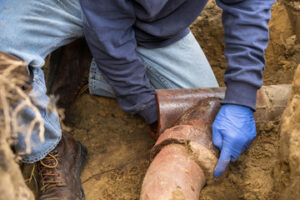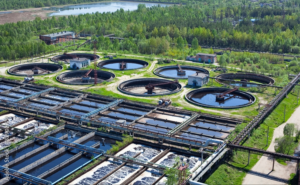The Woodlands Plumber are skilled professionals that specialize in the installation, repair and maintenance of plumbing systems. They must be familiar with a wide range of tools and equipment, as well as local building codes and regulations.
If you’re interested in becoming a plumber, consider completing a vocational program or apprenticeship to gain hands-on experience in the trade. Learn about the career requirements and salary for plumbers in your area.

Plumbers install pipes, fixtures and appliances that facilitate the distribution of water and gas in homes and buildings. They also repair and maintain these systems to ensure they function properly. This work can include laying out pipe systems, connecting appliances like dishwashers and washing machines, and inspecting plumbing components for issues such as leaks and clogs. In addition, plumbers may install and connect water supply lines for icemakers and hot water heaters.
New construction plumbers typically work with builders and architects to design and lay out plumbing infrastructure before building starts. This can involve interpreting blueprints and regulations to determine the best location for pipes, fixtures and appliances. These professionals are also responsible for ensuring that all installations adhere to relevant building codes and safety regulations.
Residential plumbers service plumbing components in homes. They may replace old toilets, faucets and fixtures, or perform whole-house re-piping when necessary. They are also responsible for installing and servicing water heaters, garbage disposals and checking all facets of the home’s plumbing to make sure everything is functioning correctly.
Commercial plumbers work with large water and waste removal systems in offices, hospitals, schools and more. These projects often require more complicated installations and connections to main sewer and water systems. In addition, these plumbers must be able to work with different types of building materials, including metal, concrete and brick.
Plumbing apprenticeship programs are the most common way for people to become plumbers. These programs usually take four to five years and include both education and on-the-job training. They may be offered through trade schools or by unions and can provide entry-level workers with the skills and experience needed to start their careers.
After completing an apprenticeship, plumbers must pass a licensing exam to become certified in their field. This certification requires a certain number of work hours and classroom instruction on topics such as plumbing codes, regulations and design. Some plumbers choose to pursue additional certification in specific areas, like green plumbing or working with particular types of equipment. Some even go on to become independent contractors, allowing them greater flexibility and control over their schedules and workload.
Repair
Plumbers repair and maintain plumbing systems in homes, businesses, and industrial buildings. These systems include pipes, fixtures, and appliances that facilitate water supply, heating and cooling, sewage disposal, and waste removal. Some plumbers specialize in specific types of systems or appliances. For example, a commercial plumber may focus on installing and repairing refrigeration systems in restaurants. A residential plumber might specialize in kitchen and bathroom fixtures, including sinks, toilets, tubs, showers, faucets, dishwashers, and water heaters.
Some common plumbing repairs include fixing leaky faucets and toilets, repairing broken pipes and water heaters, and removing clogs. Plumbers also inspect sewer pipes and clean drain lines to prevent future problems. Plumbers often work with contractors to install complete plumbing systems in new construction projects. In this role, they might create a blueprint for the pipes and install all the necessary components to ensure the system functions as intended.
Most homeowners experience some sort of plumbing problem at one time or another. Many of these issues are easy for plumbers to repair, but some are more complicated and require special training or tools. For example, a homeowner might notice a leaky faucet and think it’s an easy fix, but the problem could actually be caused by a broken pipe in the basement or an ancient water heater that needs to be replaced.
Leaking pipes are a common issue that can cause serious damage if left untreated. When a plumber fixes a leak, they typically use a patching material that provides a temporary solution while they search for a more permanent repair. Homeowners can usually tell if their pipes are leaking because of the sound of running water or stains near fixtures and pipes.
Some plumbing issues, like a clogged drain or sewer backup, can be dangerous for plumbers to handle on their own. This is because of the dangers associated with fecal matter and disease-causing microbes that can be found in human waste. Plumbers who repair sewage systems must wear protective clothing and masks to avoid exposure.
Other dangerous plumbing repairs that plumbers might make include replacing sewer line sections, repairing water heaters, and fixing backflow devices. These devices are designed to protect the environment and public health by preventing contamination of drinking water.
Maintenance
Most people don’t think about their plumbing systems until something goes wrong, but regular maintenance can help prevent costly repairs in the future. Plumbers can clean drains and toilets, repair leaky faucets and shower heads, and inspect sewer lines for any signs of problems. They may also install or replace water heaters, garbage disposals, and washers and dryers.
Plumbers often work with customers to assess their needs and provide advice on the best plumbing solutions. They must be able to listen to customer concerns and explain technical information clearly. This requires excellent communication skills, especially when dealing with customers who are stressed or upset about their plumbing issues.
Professional plumbers must be knowledgeable about building codes and regulations, blueprint reading, and safety procedures. They use tools to measure and cut pipes, and they may need to weld on occasion. Many plumbers receive formal training through an apprenticeship program that lasts four to five years and includes both classroom instruction and paid on-the-job training. Some vocational schools also offer plumbing programs.
Commercial plumbers handle larger-scale plumbing systems than residential ones, and they may work in factories, hospitals, and other large buildings. They must be familiar with the complexities of these systems and be able to diagnose and repair any problems quickly and efficiently.
Emergency services are a big part of any plumber’s job, and they must be available around the clock to respond to calls from customers. These calls can range from clogged drains to flooding basements, and they may require the plumber to make quick decisions in stressful situations. These plumbers must be able to prioritize tasks and work under pressure to meet tight deadlines.
Before the plumber arrives, it’s a good idea to take notes about any problems you’ve been experiencing and what you’ve tried to fix them. This will save time and ensure that the plumber has all the information they need to address your concerns. You should also clear away any items that might get in the way of the plumber’s work, such as furniture or toys. Finally, make sure the plumber has access to your water meter and any shut-off valves for the toilet, sinks, tubs, and showers.
Customer Service
A plumber must be able to communicate with customers effectively and explain technical issues in easy-to-understand terms. They often work with clients on an ongoing basis, so it’s important that they’re able to build rapport and trust. Plumbers should also be able to listen to customer concerns and provide advice on how best to address them.
Plumbing is a highly skilled trade that requires continuing education to keep up with industry trends and technologies. Many plumbers attend seminars and workshops to improve their skills and stay up-to-date on new equipment, tools, and techniques. In addition, some cities and counties require plumbers to renew their licensing on a regular basis.
Some plumbers specialize in specific areas of the field. For example, a construction plumber works closely with builders and architects to ensure that the plumbing systems in new buildings are installed correctly. Other plumbers may focus on service and repair, working with residential or commercial clients to resolve issues such as leaky faucets or clogged drains.
Plumbers must be able to identify the root cause of an issue and find the right solution quickly. This can involve using specialized tools to inspect pipes for damage or blockages, testing water pressure levels, and locating leaks. They may also be responsible for installing or repairing appliances such as washing machines, dishwashers, and toilets.
Plumbing is a complex career that involves extensive training and knowledge of both local building codes and national plumbing standards. Plumbers must be able to follow instructions and work safely to ensure the safety of themselves and their customers. They must also be able to solve problems quickly and efficiently, especially in emergency situations. To become a plumber, you must complete a formal apprenticeship or training program and obtain a license to practice in your area. Licensing requirements vary by location, but typically include passing an exam and having a certain amount of work experience. You can also choose to earn additional certifications to enhance your qualifications and increase your marketability.

